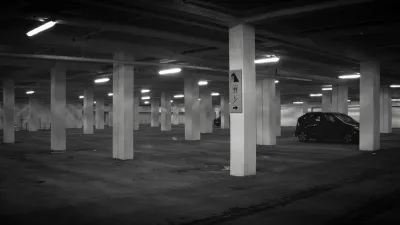Minimum parking requirements affect developer behavior most where they are most controversial: in downtown neighborhoods. In suburbs where they may just mimic the market, the arguments for such rules are paradoxically even weaker.

One common argument against the abolition of minimum parking requirements is that abolition would be futile: developers generally build as much parking as the law requires and then some.
A recent article in Access magazine by Cornell planning professor Michael Manville suggests otherwise. Manville studies the impact of Los Angeles’ "Adaptive Reuse Ordinance" (ARO), which provides that landowners who convert downtown commercial/industrial land to residential use need not build additional parking, even if city ordinances would otherwise require such parking.
Manville finds that the overwhelming majority of ARO landowners provided some parking: only 13 percent of ARO apartments, and 31 percent of condominium buildings, were completely parking-free. However, this statistic underestimates landowners’ use of the flexibility provided by the ordinance, since some of the buildings may have had preexisting parking.
In addition, ARO buildings typically provided less parking (or at least less on-site parking) than Los Angeles law requires for other buildings.For condos, Los Angeles typically requires two parking spaces per unit; however, the minimum ARO unit provided 1.3 spaces. ARO apartment units typically complied with the city’s one-space-per unit requirement; however, ARO apartment parking spaces, unlike most Los Angeles parking spaces, are often off-site. The typical ARO unit had only 0.6 parking spaces; thus, many landowners leased parking from nearby parking spaces, providing the developers with additional flexibility and reducing housing costs.
Manville points out that his findings are limited to downtowns, where parking may be more expensive and people are more willing to live car-free. By contrast, in low-density suburban areas where parking is cheap and driving is universal, developers may be more willing to build huge amounts of parking. Yet the latter areas are, it seems to me, the least willing to experiment with parking reform.
These conclusion, if true, suggests a paradox: minimum parking requirements are most popular precisely where they have the least impact. If suburban landowners will build more parking than the law requires, isn’t the law kind of pointless?
The traditional argument for minimum parking requirements is that they prevent people wasting fuel and time cruising for scarce parking spaces. But if suburban landowners will always build parking, there is no scarcity and hence no cruising.
A second argument for minimum parking requirements is that they prevent "spillover parking": that is, people parking in residential areas, inconveniencing residents who crave on-street parking spots. But this argument does not apply to many suburban areas because if parking is nearly always abundant, such spillover parking will never occur. Moreover, suburbanites are less likely to use parking than city drivers, because they usually park in their own driveways and garages.
So in car-oriented suburbs, minimum parking requirements may not do much harm- but they don’t do much good either.

National Parks Layoffs Will Cause Communities to Lose Billions
Thousands of essential park workers were laid off this week, just before the busy spring break season.

Retro-silient?: America’s First “Eco-burb,” The Woodlands Turns 50
A master-planned community north of Houston offers lessons on green infrastructure and resilient design, but falls short of its founder’s lofty affordability and walkability goals.

Delivering for America Plan Will Downgrade Mail Service in at Least 49.5 Percent of Zip Codes
Republican and Democrat lawmakers criticize the plan for its disproportionate negative impact on rural communities.

Test News Post 1
This is a summary

Test News Headline 46
Test for the image on the front page.

Balancing Bombs and Butterflies: How the National Guard Protects a Rare Species
The National Guard at Fort Indiantown Gap uses GIS technology and land management strategies to balance military training with conservation efforts, ensuring the survival of the rare eastern regal fritillary butterfly.
Urban Design for Planners 1: Software Tools
This six-course series explores essential urban design concepts using open source software and equips planners with the tools they need to participate fully in the urban design process.
Planning for Universal Design
Learn the tools for implementing Universal Design in planning regulations.
EMC Planning Group, Inc.
Planetizen
Planetizen
Mpact (formerly Rail~Volution)
Great Falls Development Authority, Inc.
HUDs Office of Policy Development and Research
NYU Wagner Graduate School of Public Service





























